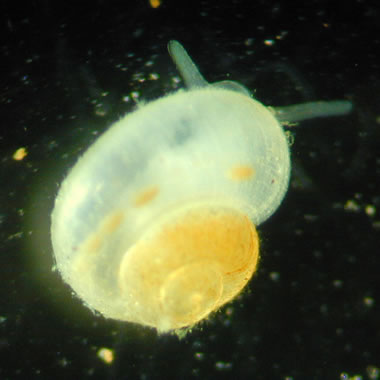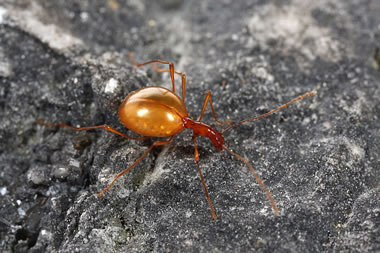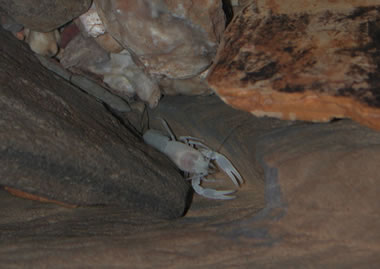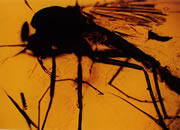Troglobites: Animals that Live in a Cave
Article by: Hobart M. King, PhD, RPG

Cave snail: The Tumbling Creek cavesnail, Antrobia culveri, is a small (1/10 inch long) aquatic snail that lives in a stream that flows through Tumbling Creek Cave in Taney County, Missouri. It is a blind albino. Public domain photo by David Ashley of the U.S. Fish and Wildlife Service.
What are Troglobites?
Troglobites are small creatures that have adapted to a permanent life in a cave. They are so well-adapted to life in a cave that they would be unable to survive in the surface environment. To survive in the darkness, troglobites have highly developed senses of hearing, touch and smell.
Table of Contents
 How Animals Adapt to Cave Life How Animals Adapt to Cave Life The Discovery of Troglobites The Discovery of Troglobites How Many Species of Troglobites? How Many Species of Troglobites? What Do Troglobites Eat? What Do Troglobites Eat? Other Cave Animals Other Cave Animals Troglophiles Troglophiles Trogloxenes Trogloxenes Pet Troglobites? Pet Troglobites? |
Troglobites: Strange Cave Specialists: This short video from BBC Earth shows some species of troglobites from different parts of the world.
How Animals Adapt to Cave Life
Troglobites often start out as surface species who, by accident, get stranded in a cave. Maybe a stream washed them into the cave, or maybe they wandered in and became stranded. If multiple animals of the same species, capable of reproducing, get stranded in a cave, they might be able to evolve - over multiple generations - into a new Troglobite species.
The darkness of the cave eliminates their need for sight. As a result, they are usually blind with undeveloped eyes that might be covered by a layer of skin. The darkness eliminates the advantage of camouflage coloring, and many troglobites are albino.
Many types of animals have evolved into troglobites. Some of the most familiar types of troglobites are spiders, beetles, gastropods, fish, millipedes, and salamanders. Turbellarians, pseudoscorpions, harvestmen, isopods, amphipods, decapods, collembolans, and diplurans are also represented in Earth's troglobite collection.

Troglobite "dragon": Sketch of an olm (aquatic salamander) that was published in Specimen Medicum, Exhibens Synopsin Reptilium Emendatam cum Experimentis circa Venena by Josephus Nicolaus Laurenti in 1768.
The Discovery of Troglobites
The first known discovery of a troglobite occurred in Slovenia in the 1600s. Heavy rains flooded cave systems in the area, and gushing springs carried a number of mysterious creatures to the surface. They were small flesh-colored serpent-like creatures a few inches long with legs and a flat wedge-shaped head.
The people who found these dead animals were alarmed. They thought that they had found the undeveloped offspring of subterranean dragons! A rich mythology of subterranean dragons developed from this discovery, and Slovenian folk stories about them are still told today.

Cave beetle: Beetles are a common troglobite. This beetle, Leptodirus hochenwartii from Slovenia, has lost its eyes, wings and pigment in adapting to cave life. This image by Yerpo is used under a Creative Commons license.
How Many Species of Troglobites?
Over 7700 species of troglobites have been discovered. Although that might sound like a surprisingly high number, researchers believe that it is just a small fraction of the total number of Earth's troglobite species. This number is low because many caves have been poorly explored and even fewer have had a thorough biological census. More importantly, the number of caves that have been discovered is thought to be just a tiny fraction of all of the caves that exist.
The number of different species is also very high because troglobites evolve in isolation. A species evolves in a single cave, and because it cannot survive outside of the cave environment, that species cannot spread to other caves. This means that every cave has the potential to host a unique assemblage of troglobite species.
Creatures of the same species can even evolve into separate species within the same cave. For example, if spiders of the same species wandered into separate passages of a cave, independent instances of evolution could happen in each one of those passages - because the conditions in each of those passages could be unique enough to produce a different evolutionary outcome.

Blind cave fish: This blind cave fish, Astyanax jordani, is found in Mexico. This image by OpenCage is used under a Creative Commons license.
What Do They Eat?
Most troglobites are sedentary organisms that do not burn a lot of calories. They obtain most of their food from scavenging. Their diet might include: small pieces of plant debris carried into the cave by running water, bacteria and plankton that live in cave waters, carcasses of animals that have died in the cave, and feces of other animals scavenged from the cave floor. Bat guano can be the primary food for troglobites living in caves with an active bat population.

Cave crayfish: Photograph of a cave crayfish, Orconectes australis, by Marshal Hedin is used under a Creative Commons license.
Other Cave Animals
Troglobites are such specialized animals that they must live in the cave to survive. However, there are two other categories of animals that spend time in the cave environment. These are troglophiles and trogloxenes.
Troglobite crayfish: This video documents the environment and characteristics of cave crayfish. Produced by Ravenswood Media, Inc.
Troglophiles
Troglophiles are animals who spend part or all of their lives in a cave. They differ from troglobites in that they have not adapted to permanent life in a cave. They are able to survive outside of the cave in the appropriate environment. They have not lost their vision or their pigment. Some troglophiles might have reduced visual abilities or partial pigmentation. If their descendants remain in the cave long enough, they could adapt into troglobites.
Trogloxenes
Trogloxenes are the type of cave animal that most people are familiar with. They use caves overnight or during the winter as places to sleep or hibernate. Bats and bears are well-known trogloxenes. Some types of birds, snakes, and insects are trogloxenes. Humans might not be considered trogloxenes today, but thousands of years ago many humans used caves as a regular place of shelter.
|
Five Amazing Adaptations That Help Animals Thrive in the Dark From snakes that use infrared radiation to find prey, to deep-sea fishes that communicate via bioluminescence, these creatures flourish without light. If you enjoyed reading about troglobites, you will probably like this article on the Smithsonian Magazine website. |
Pet Troglobites?
One type of troglobite that is occasionally seen in pet shops is the "blind cave fish." These are often forms of the Mexican tetra (Astyanax mexicanus) that have adapted to life in a cave but have been removed for commercial propagation. It has no eyes and is albino. It can be kept in an aquarium and can compete successfully for food in a mildly aggressive community.
| More General Geology |
 |
Spectacular Fossils |
 |
What is the San Andreas Fault? |
 |
Bubbles in Amber |
 |
Geology Dictionary |
 |
Igneous and Volcanic Features |
 |
Fossils |
 |
Diamonds |
 |
Minerals |

Find Other Topics on Geology.com:

|

| ||

|

| ||

|

| ||

|

|
